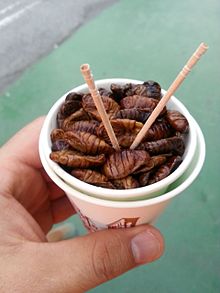
Back Insectes com a aliment Catalan Speiseinsekt German حشرات خوراکی Persian חרקי מאכל HE Gegremet minangka panganan JV 식용 곤충 Korean စားစရာအင်းဆက်ပိုးမွှားများ Burmese Insetos comestíveis Portuguese Insecte ca sursă de hrană Romanian Insektet si ushqim Albanian



Insects as food or edible insects are insect species used for human consumption. Over 2 billion people are estimated to eat insects on a daily basis.[1] Globally, more than 2,000 insect species are considered edible, though far fewer are discussed for industrialized mass production and regionally authorized for use in food.[2][3][4][5] Many insects are highly nutritious, though nutritional content depends on species and other factors such as diet and age.[6][7] Insects offer a wide variety of flavors and are commonly consumed whole or pulverized for use in dishes and processed food products such as burger patties, pasta, or snacks.[8][9] Like other foods, there can be risks associated with consuming insects, such as allergic reactions.[10] As commercial interest in insects as food grows, countries are introducing new regulatory frameworks to oversee their production, processing, marketing, and consumption.[11]
- ^ Pap, Fundacja (2018-03-05). "Expert: More than 2 billion people worldwide eat insects every day". Science in Poland. Retrieved 2022-02-27.
- ^ Cite error: The named reference
van Huis-2013was invoked but never defined (see the help page). - ^ Cite error: The named reference
Jongema-2017was invoked but never defined (see the help page). - ^ Cite error: The named reference
rumbos-anthassiou-2021was invoked but never defined (see the help page). - ^ Cite error: The named reference
van-Huis-2017was invoked but never defined (see the help page). - ^ Rumpold, Birgit A.; Schlüter, Oliver K. (2013). "Nutritional composition and safety aspects of edible insects". Molecular Nutrition & Food Research. 57 (5): 802–823. doi:10.1002/mnfr.201200735. PMID 23471778.
- ^ van Huis, Arnold; Rumpold, Birgit; Maya, Cassandra; Roos, Nanna (2021-10-11). "Nutritional Qualities and Enhancement of Edible Insects". Annual Review of Nutrition. 41 (1): 551–576. doi:10.1146/annurev-nutr-041520-010856. ISSN 0199-9885. PMID 34186013. S2CID 235687857.
- ^ Cite error: The named reference
Perez-Santaescolastica-2022was invoked but never defined (see the help page). - ^ Melgar‐Lalanne, Guiomar; Hernández‐Álvarez, Alan‐Javier; Salinas‐Castro, Alejandro (2019). "Edible Insects Processing: Traditional and Innovative Technologies". Comprehensive Reviews in Food Science and Food Safety. 18 (4): 1166–1191. doi:10.1111/1541-4337.12463. ISSN 1541-4337. PMID 33336989. S2CID 198255011.
- ^ Cite error: The named reference
Huis-2022was invoked but never defined (see the help page). - ^ Lähteenmäki-Uutela, A.; Marimuthu, S.B; Meijer, N. (2021-08-13). "Regulations on insects as food and feed: a global comparison". Journal of Insects as Food and Feed. 7 (5): 849–856. doi:10.3920/JIFF2020.0066. ISSN 2352-4588. S2CID 234843309.
© MMXXIII Rich X Search. We shall prevail. All rights reserved. Rich X Search